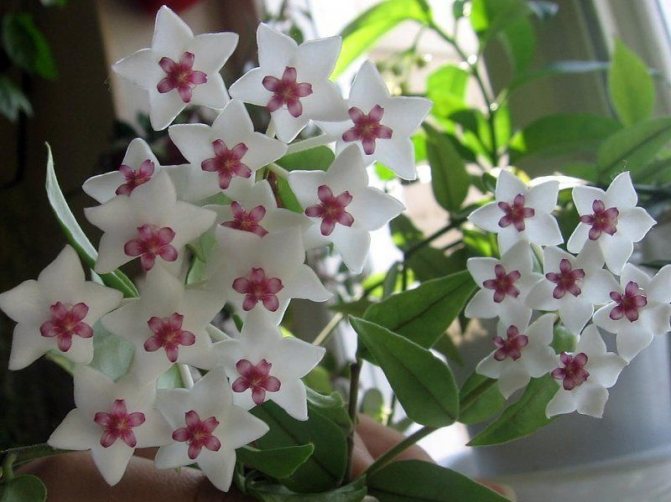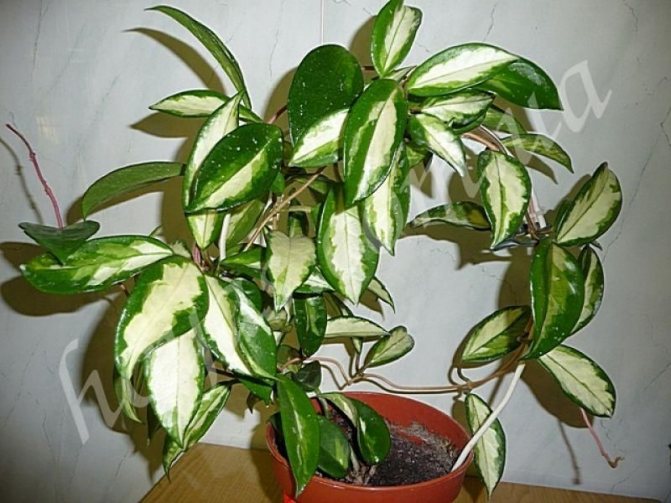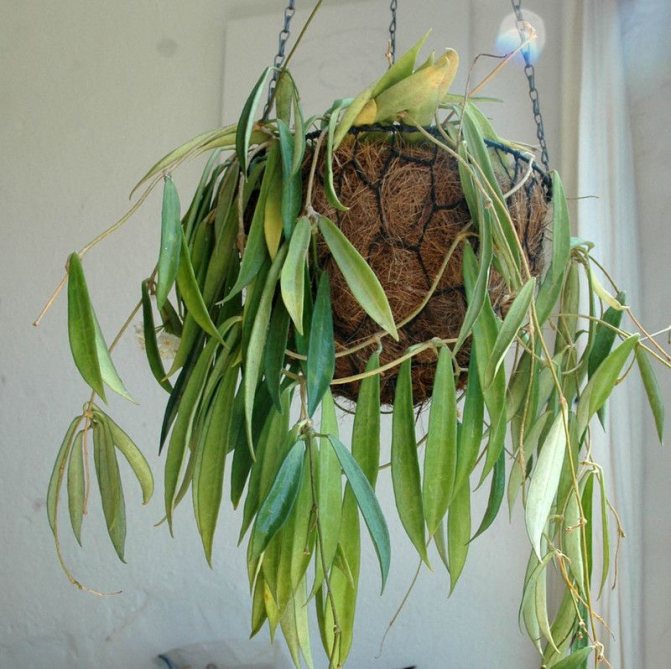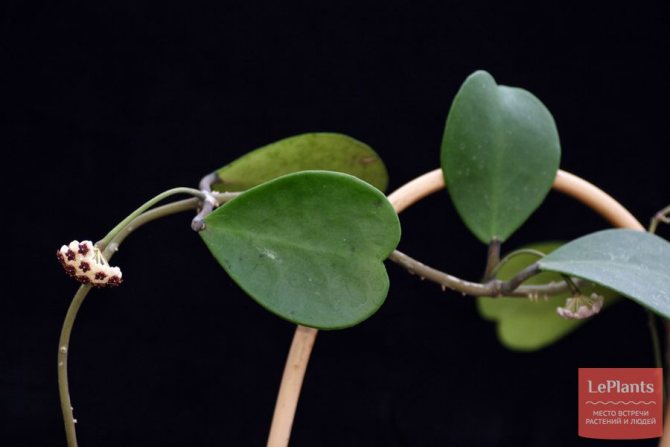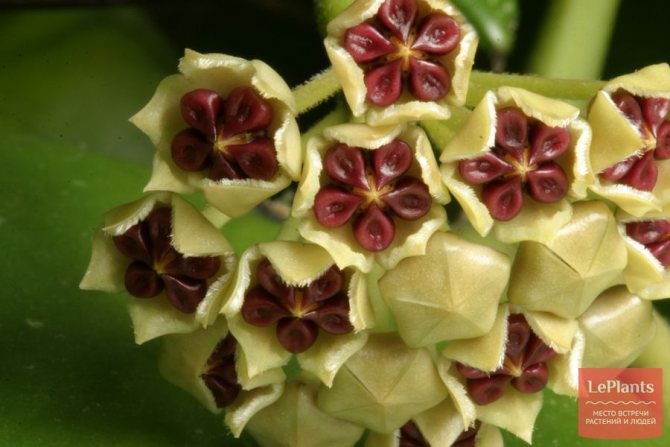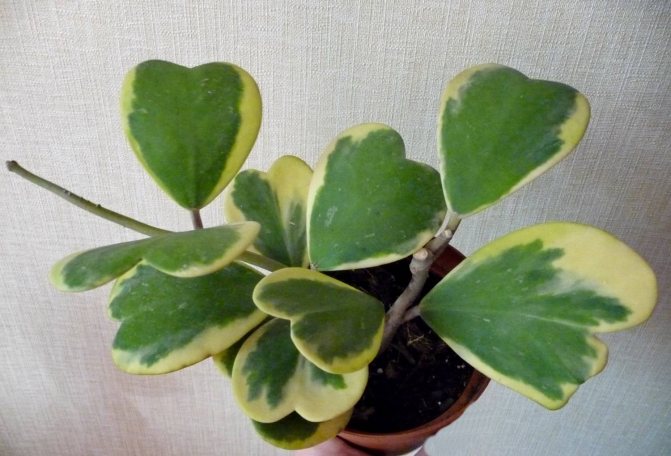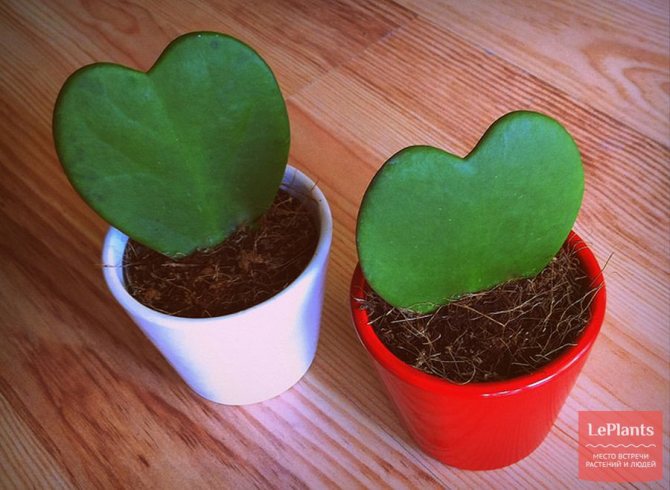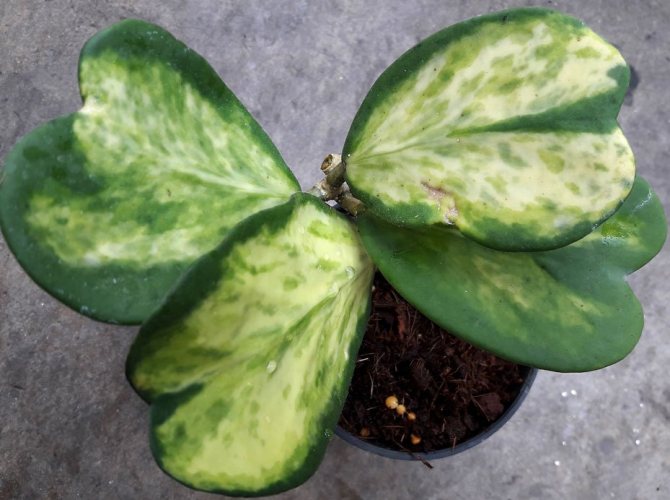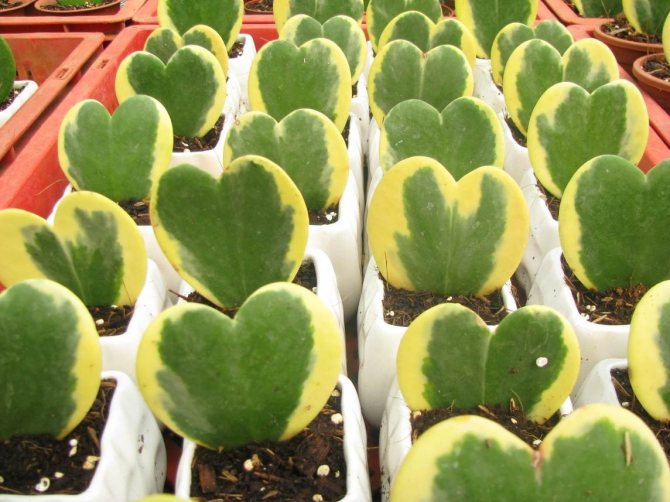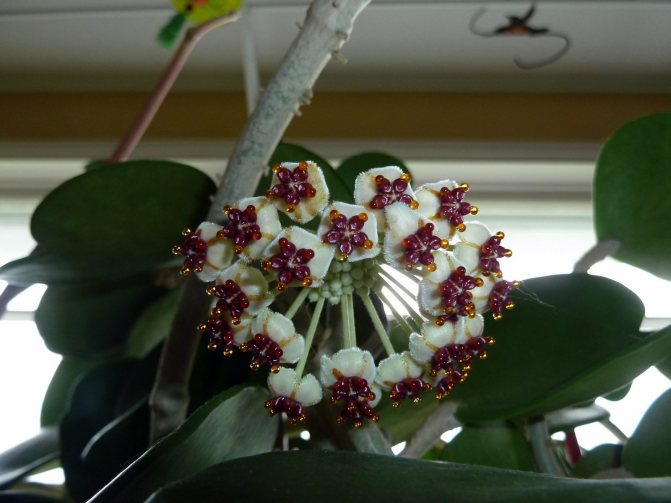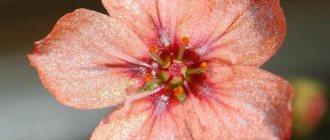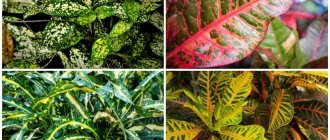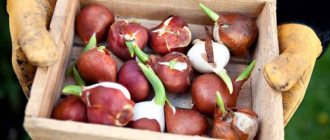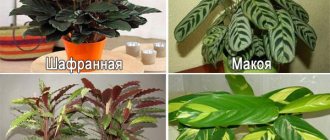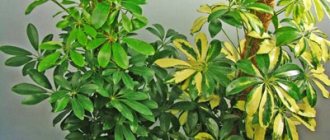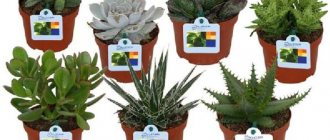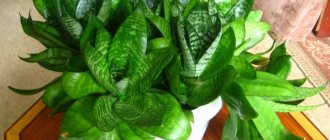Can hoya be kept at home as wax ivy?
Hoya got a comparison with ivy for long creeping stems. In nature, they lean on trees, hanging from them (epiphytes).
Despite all the beauty some growers are afraid to bring hoya into the house because of bad omens... It is believed that ivy brings misfortune, and therefore the vine provokes strife and drives people dear to the owner, especially men, out of their homes. But actually hoya has nothing in common with ivy, therefore, these signs are not supported by anything.
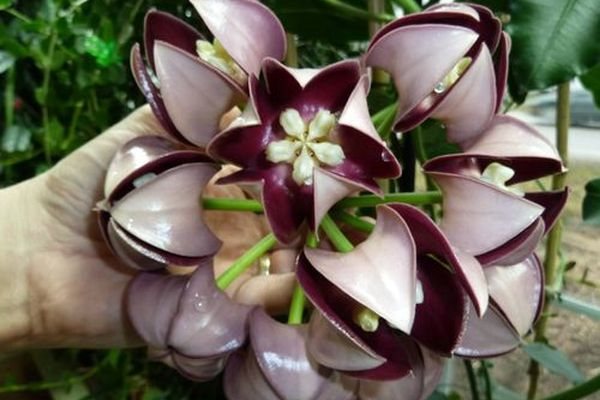
According to feng shui, the plant, on the contrary, creates comfort and coziness in the room... Belief in the ability to resolve conflicts explains her location in the bedroom or in the room where household members gather most often.
Hoya pests
Root nematodes Are microscopic worms that live in the roots. The result of their harmful action is the swelling and decay of the roots. To get rid of parasites, you need to remove the plant from the soil, peel the roots and rinse them in hot water - + 55 ° С. Also disinfect the pot and new soil. After transplanting a flower, treat it with insecticides according to the instructions.
Shields - small insects that feed on plant sap. They stick to foliage or stem and resemble brown or red cocoons. As a result of the actions of pests, the leaves turn yellow and fall off, and the stems do not develop correctly. Insecticides will help to cope with scale insects.


Main types and varieties
Most varieties of hoya are vines with dark leaves covered with a waxy bloom. Average growth rate - 20-30 cm per year... There are also species with erect shoots, for example, hoya multiflora.
Leaves are solid green, oval-lanceolate. The flowers of waxy ivy are of the greatest value. Each bud has the shape of a star with a diameter of up to 2 cm, and in its center there is a contrasting core of the same star, only of a smaller size.
The buds are collected in umbellate or hemispherical inflorescences. On one liana, they can be counted up to 20 pieces. The color range and shape of the inflorescences underlie the species and varietal differences of the hoya.
Beautiful, or bella
Hoya Bella grows in the form of delicate branches with elongated leaves. White buds are collected with an umbrella of 9 flowers with a pink heart.
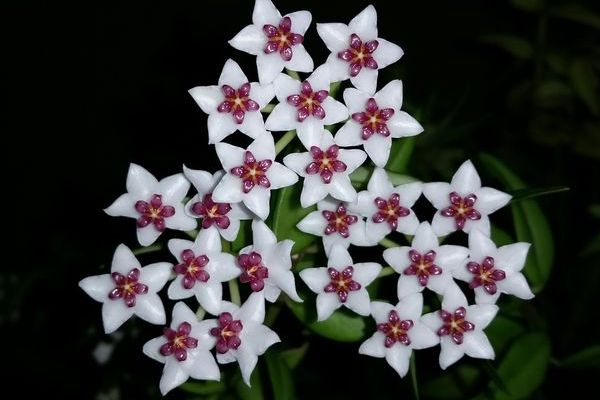

Kerry
Hoya Kerry is a liana with shoots up to 2 m, on which large leaves (more than 10 cm) are in the shape of a heart and aerial roots. The flowers are white at the base, pubescent along the edge, and yellow in the middle.


Over the years, the flowers on the liana become darker.
Interesting! This species was first found by the American A. Kerry in the north of Thailand in 1911.
Fleshy
Hoya fleshy has dark oval leaves, along the edge of which a light rim of a yellowish tint is noticeable. The stems eventually become covered with coarse bark. The pink flowers are fleshy, not blooming to thin petals.
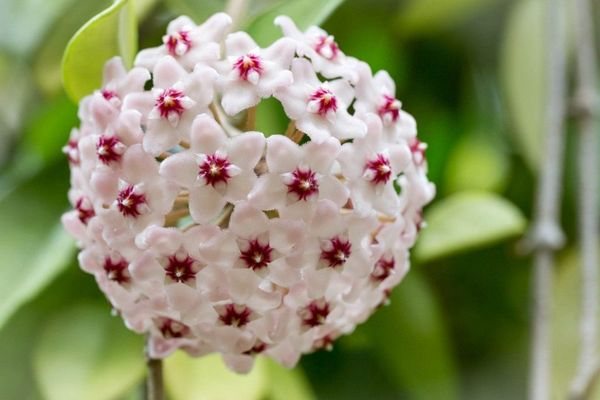

Lacunose
Hoya lacunose is an epiphyte with diamond-shaped leaves on straight shoots. Needs the forced formation of the crown, since it does not curl itself. Inflorescences in the form of a white umbrella with red-yellow stars, from which a pleasant aroma emanates throughout the room.
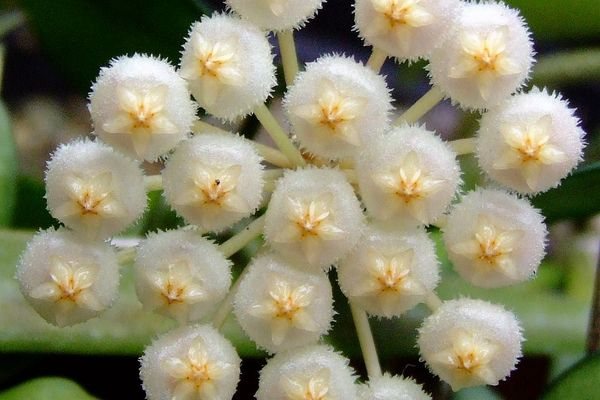

Matilda
Shoots curly, covered with oval leaves with silvery spots.Fragrant greenish-white flowers can bloom almost all year round.
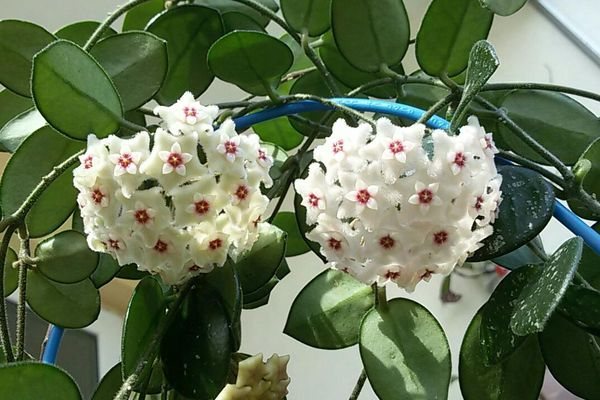

Tricolor
It is otherwise known as karnosa hoya. Its leaves are very unusual and colorful - a creamy middle, a green rim along the edge and red veins. The flowers of the hoya tricolor are lilac with a dark center.
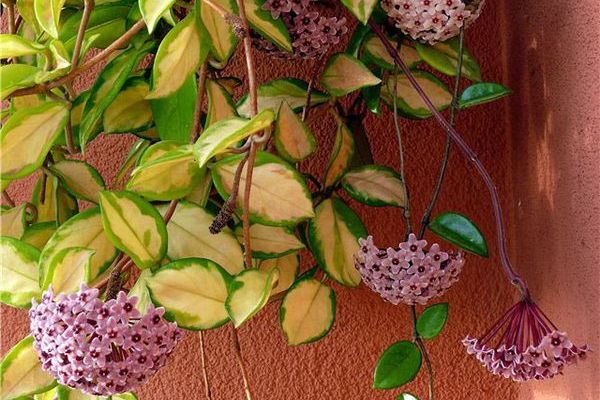

Compact
Hoya compacta is distinguished by curled leaves that fold along the central vein. Inflorescences appear compact against the background of an overgrown crown. The flowers are colored in several shades of pink.


Obscura
Veins darker than the main color are noticeable on the leaves. Buds with a backward-curved pink base and a pale yellow center.
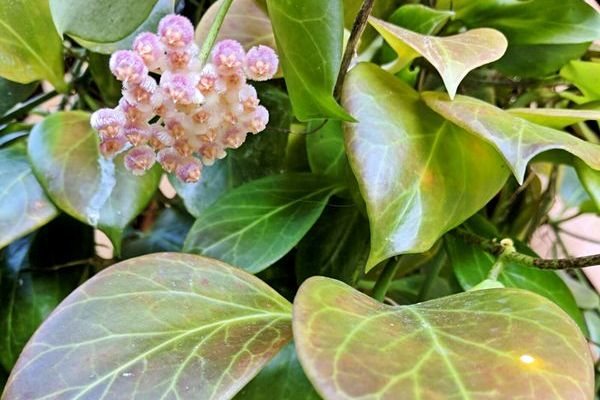

Linearis
The leaves can rather be called soft needles, since they grow in the form of long tubes, pubescent over the entire surface. Beige inflorescences hang from the shoots like bunches. The aroma is lilac or vanilla.
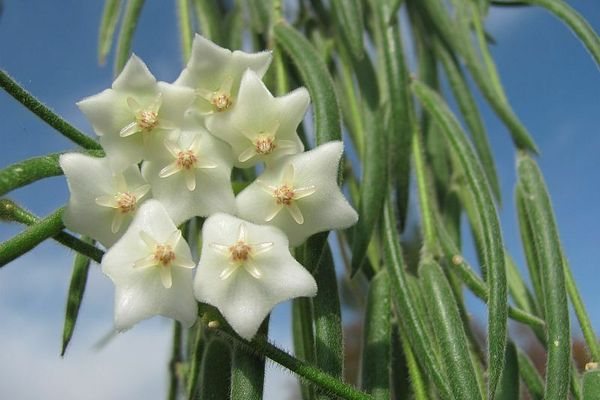

Gracilis
The graceful liana grows in the form of long stems with narrow leaves that form a lush crown. Inflorescences of a pink shade with petals bent back.
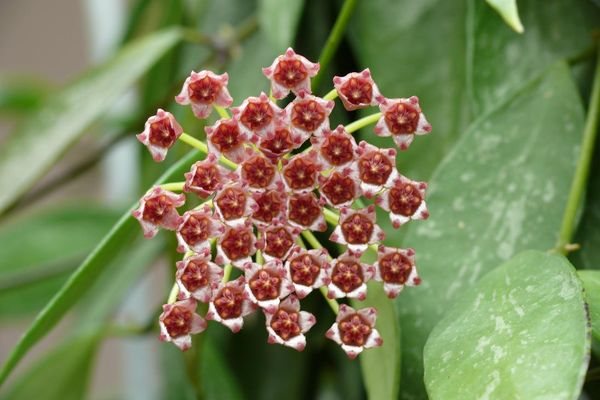

Retuza
The original shape of the leaf is in the form of a narrow strip with a bifurcation at the top. Single flowers are scattered along the entire length of the shoots. Their main color is white, and the little star is cherry-burgundy.
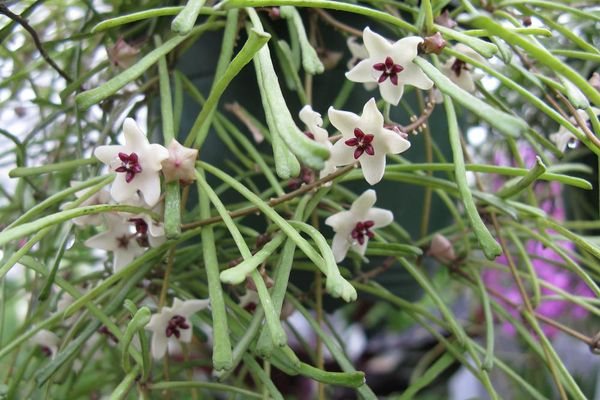

Australian
It is a liana with dense oval leaves and beige-pink flowers.
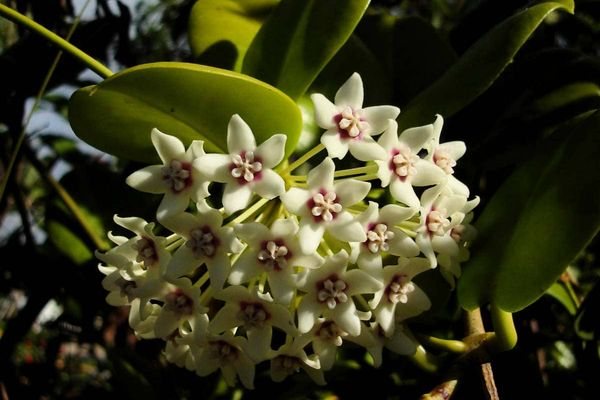

Tsangi
Native to the Philippine Islands, Epiphyte has fleshy diamond-shaped leaves and orange-yellow honey-scented buds.


Obovata
Flowering is abundant, and the plant is unpretentious in care, it is easy to root. The leaves are rounded with small white specks. Each inflorescence contains about 30 pink "stars" with small crimson crowns in the center.
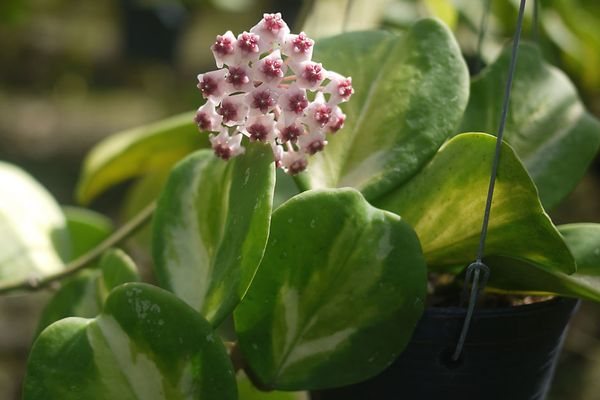

Majestic
Corresponds to its name in size: branching shoots in greenhouses can reach 8 m, and leaves - 20 cm. Flowers are also large, 10 pieces per inflorescence. The large outer petals are fleshy, with pointed tips of burgundy color, and the core is beige with a fruity scent.
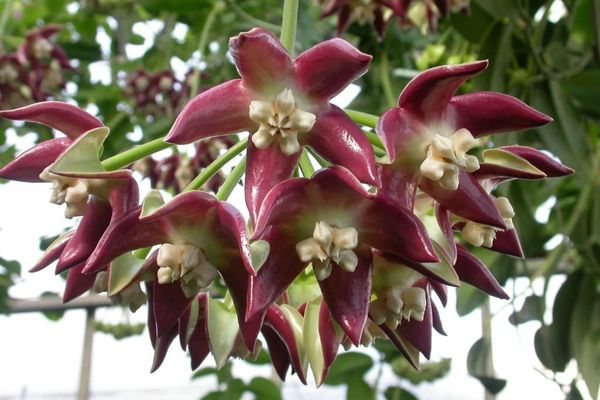

Curtisi
The epiphyte clings to any support with a multitude of aerial roots growing from each sinus. The leaves are small, heart-shaped with dotted blotches. Flowers with fleshy petals of beige and pink shades.
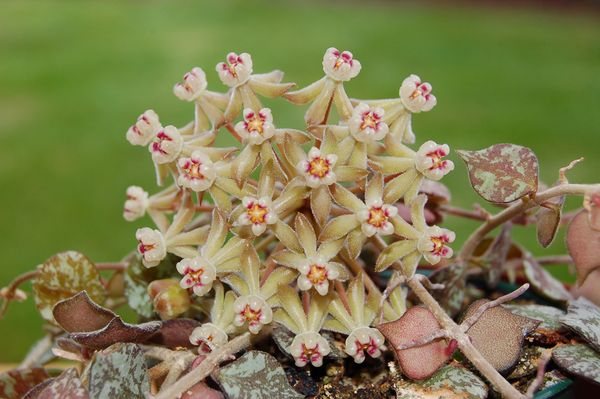

Pachyclada
Thick-stemmed epiphyte with branching shoots and fleshy leaves. More than 20 snow-white buds with a sweet aroma are collected on a short peduncle.


Lasianta
The bushy hoya is covered with thin variegated leaves and orange-yellow flowers, the large petals of which are completely turned back.
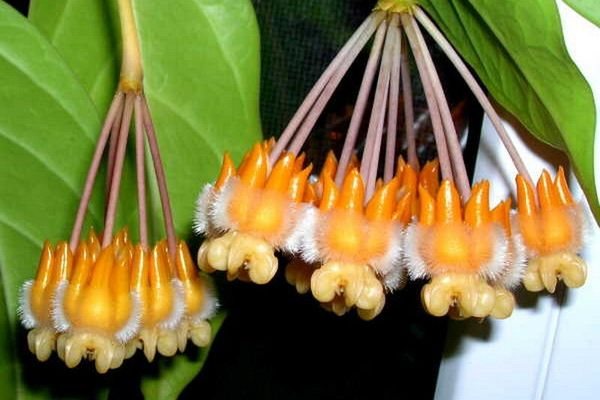

Polineira
On the leaves of this type, all the veins stand out with a bluish tint, due to which the effect of the tail of a goldfish is obtained. The flowers are beige and cherry.
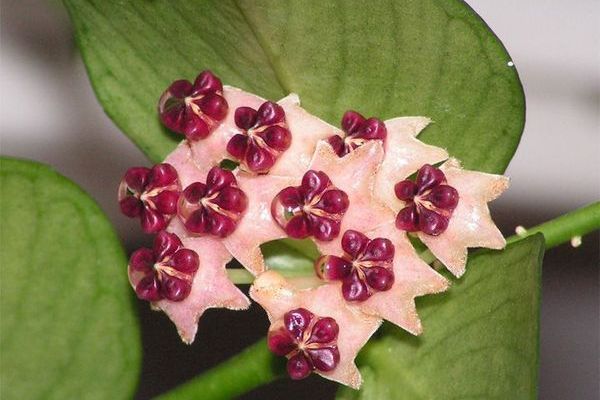

Meliflois
A fast growing variety with long shoots, it needs constant pruning. The scent of pink-orange flowers can be felt even from a distance.
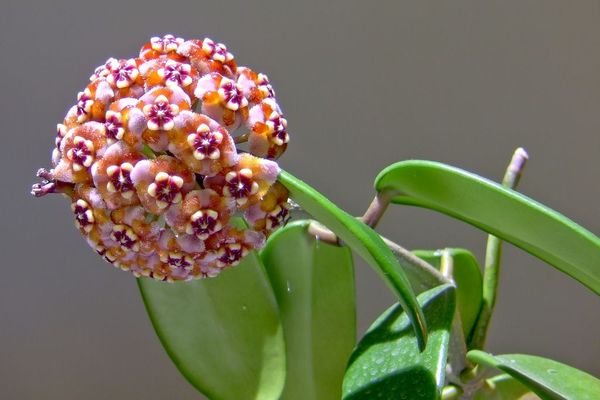

Elliptical
This species can be found, perhaps, only among rare private collections. The leaves with rounded tops have pronounced veins, and the pearl-colored flowers smell sweet in the evenings.


Globulose
Inflorescences of a yellowish-beige hue acquire the shape of an almost perfect ball, for which the species received its name. Shoots branch well, covered with bark, and leaves with long hair.
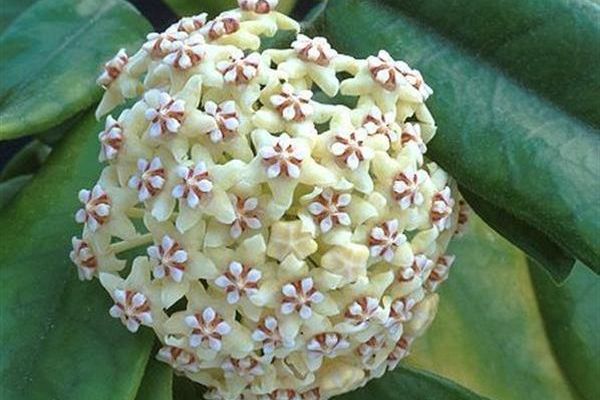

Caudata
The leaves of the hoya caudata are dense, reaching a length of 15 cm. The flowers are not bright, but stand out with long villi along the edges of large petals.
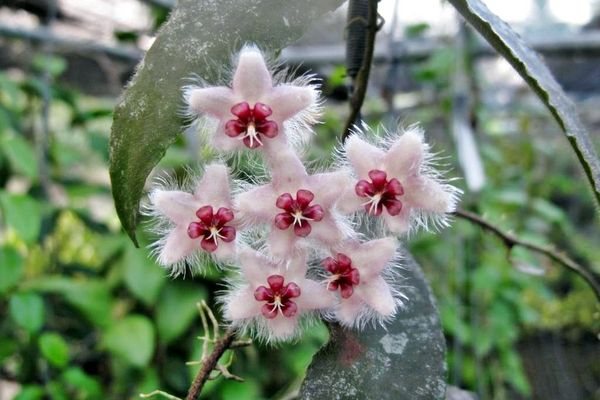

Vayeti
Hoya vayeti is a liana with fluffy wine-red flowers and odorless sticky nectar. It is necessary to give the desired shape to this species from youth, since in mature plants the shoots become lignified.
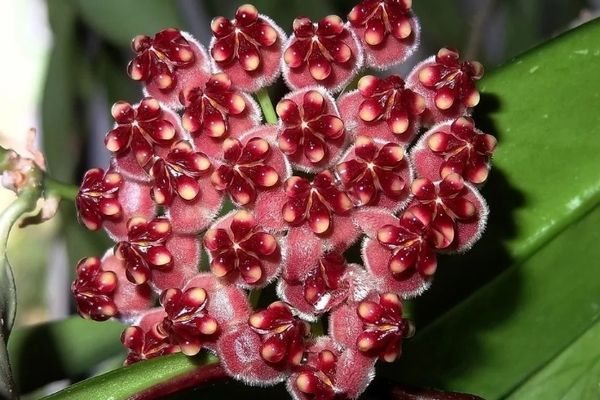

Description
Hoya kerry belongs to the genus of evergreen tropical lianas.Her homeland is South Asia, Australia, Polynesia.


The plant has become popular for its heart-shaped leaf. Each heart is fleshy, up to 15 cm long. Hoya kerry has several subspecies, which differ slightly in the color of the leaves: speckled, variegated, with white edges.
Did you know? The scientific name of this vine consists of two surnames: the genus was named after the gardener of the Duke of Northumberland, Thomas Hoya, and the species itself bears the name of its discoverer, D. Kerr.
Particularly caring owners will have a chance to see the flowering of this succulent. Flowers are medium-sized, collected in inflorescences. They can be white, yellow or pinkish. The saturation of their color depends on the intensity of the light. They resemble stars in shape.
The flowering period lasts from June to October. The peak is in July and September. At this time, the flowers emit especially a lot of aromatic nectar, reminiscent of caramel.
Like Hoya Kerry, succulents also include pachypodium, ripsalis, euphorbia, staple, mammillaria, echeveria, haworthia, aichrizona, agave.
Home care
Creating an optimal microclimate and maintaining it all year round are seemingly familiar requirements for plant breeders. but home care for hoya has important nuances.
Temperature
It is recommended to keep the flower at a temperature of 18 ... 25 ° C. In winter, the appearance of the plant remains the same when the thermometer is above 15 ° C. A lower temperature provokes leaf fall, followed by a difficult recovery period.
Important! Hoya beautiful does not tolerate temperatures below 18 ° C.
Location, lighting
For lianas from the tropics, favorable lighting conditions are near the east or west window of the apartment. In winter, when the intensity of sunlight decreases, the pot can be moved to the south side.
View this post on Instagram
Publication from Hoya from all over the world (@nastyahoya) 7 Sep 2019 at 12:06 PDT
Daylight hours for vines should last at least 10 hours at any time of the year. Backlighting in winter is especially needed for species with variegated leaves.... Varieties with a monochromatic dark color will tolerate a short partial shade.
Advice! You can not rearrange (even turn) the vine during the budding period. Whenever the location is changed, the hoya resets the entire typed color.
Flowering features
All types of hoya differ in the shade and shape of the flowers. Each bud retains its attractiveness for almost 3 weeks, and a new one appears in the place of the dropped one. Due to this feature, the flowering period is often extended throughout the summer. Most varieties exude a unique aroma at peak flowering.tangible in a few steps.
Watering
Watering varies depending on the type of vine. Most varieties with fleshy leaves are watered after the substrate dries up to 3 cm. If the leaves are thin or with a pile, then they always need slightly moistened soil.
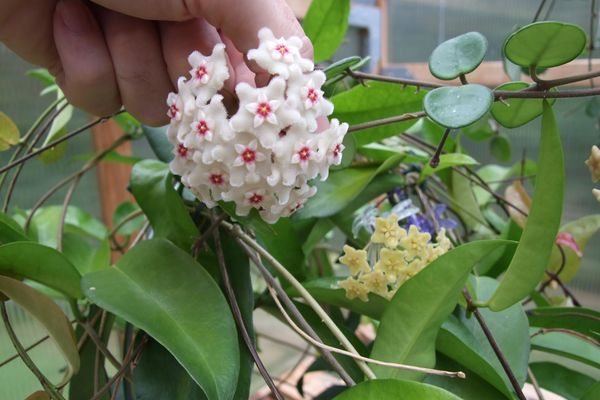

Bathing
Bathing is an unusual way to stimulate hoya blooms:
- The pot is lowered into a basin of warm water (up to 40 ° C) for 3 hours.
- If the plant is immersed together with the leaves, then the duration of the procedure is reduced to half an hour.
- After that, the liana with earth is dried in warmth with diffused lighting.
The manipulation is recommended to be carried out in early spring and autumn before the dormant period.
Air humidity
Experienced growers note that regular spraying improves flowering and accelerates growth... During flowering, be careful not to let the water get on the petals. It is better to replace for this spraying period by wiping the leaves. This procedure should also be carried out to remove dust 2-3 times a month.
View this post on Instagram
Posted by Meldika (@ meldi.ka) Jun 27, 2020 1:08 am PDT
Transplant and pot
Despite the rapid growth rates, the liana does not have to change the pot every year. On the contrary: in a small cramped area, the hoya blooms more abundantly.
It is recommended to renew the substrate and flowerpot every 2-3 years.
Advice! If you want to grow a hoya with a massive crown, the pot is selected a little more, and the plant is transplanted annually. Then the liana will not bloom and will direct all its forces to the growth of greenery.
The pot must be new.... How much to increase its diameter - 5 or 3 cm - depends on the desire to get greens or flowers.


The transplant itself is carried out in the following sequence:
- Fill the bottom of the new pot by 4 cm with drainage.
- Fill the top with prepared soil up to a quarter of the height of the flowerpot.
- Install a support if necessary. It is advisable to use metal arcs or gratings that can withstand the weight of the green mass.
- Remove the plant from the pot, previously watered for half an hour, without damaging the earthen lump with roots.
- Transplant into a new flowerpot and cover the free space with earth.
- Water a little and, if necessary, top up the substrate on top.
Caring for a transplanted hoya is simple: reduce watering, protect the leaves from sunlight and dry air.


Soil and fertilizers
The approximate composition of the soil may be as follows:
- peat, leaf soil, river sand and humus in equal parts;
- universal soil, humus and loam in a ratio of 1: 1: 2;
- substrate for orchids and universal soil for flowering plants in equal volumes.
Important! The acidity of the finished composition should be neutral or slightly acidic.
Hoye feeding is needed regularly during the period of active growth. (spring - mid-autumn). Among the ready-made solutions, the choice can be stopped on fertilizer for succulents or flowering indoor plants. To replenish the composition of nutrients, it is enough to water twice with additional feeding per month.
Pruning
Hoya will look attractive over the years if, in addition to leaving the vine is cut regularly - best in the fallwhen the flowering stopped.
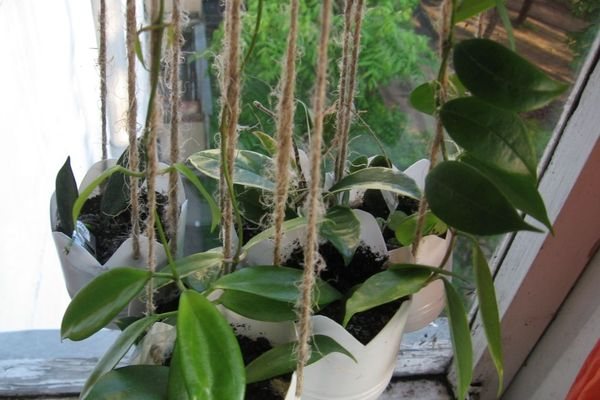

The branches hanging from the pots are cut in half. It also stimulates abundant flowering in the next season.
Important! After the buds fall, the peduncles are not cut off. Hoya forms new inflorescences on them next year.
Content
- Hoya species and varieties photo
- Hoya home care
- Hoya watering
- Hoya soil
- Hoya transplant at home
- Hoya pot
- Fertilizers for hoya
- Hoya pruning
- Hoya bloom
- Hoya in winter
- Hoya propagation by seeds
- Hoya propagation by cuttings
- Hoya leaf propagation
- Hoya diseases
- Hoya pests
- Hoya's healing properties
- Cooking recipes
Reproduction
Hoya reproduction is carried out in any way available to the plant.
Seeds
It is too time consuming to propagate a vine by seeds, and the result does not live up to expectations. Even breeders, trying to get hybrids, rarely find the desired maternal traits in their offspring.
But if you're willing to take the risk, then for seeds, prepare a mixture of fine sphagnum crumbs and universal soil in equal volumes... The greenhouse is kept at 25 ° C and the soil should be slightly damp.
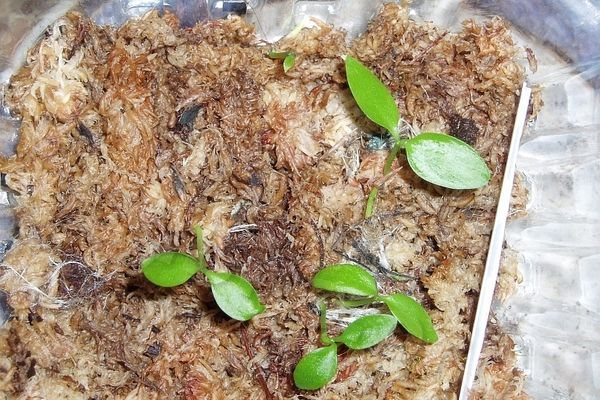

Seedlings will appear in a week, and the formation of 2 pairs of leaves takes another 3 months... After that, the sprout is transplanted into permanent soil.
Layers
Indoor flower over 5 years old reproduces stem layering... The advantage of this option is undeniable, because a young plant will bloom in the first year after planting.
- A circular incision is made on the shoot between the leaves with a sharp knife.
- The place of damage is wrapped in moss. It needs to be impregnated with a biostimulant.
- From above everything is covered with a film.
- Soon the roots will be visible through the moss.
- The cuttings are cut from the mother plant and transplanted into a new pot.
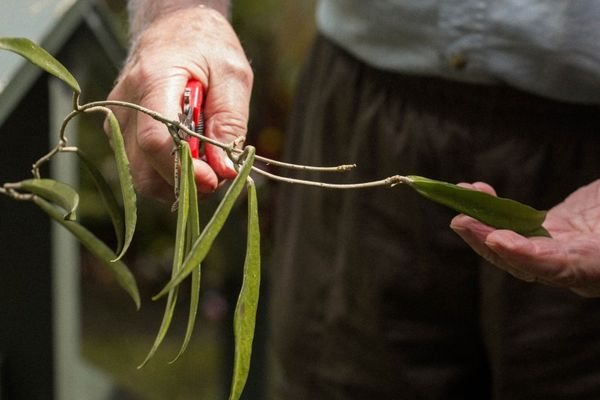

Cuttings
The material is prepared from the tops of the shoots during pruning. For rooting, you need to leave a few pairs of leaves and 2 points of growth.
The cut shoot lies at room temperature for 3 hours, then the tip is sprinkled with a root formation stimulator. The roots appear both in a wet mixture of peat and sand and in water.
Advice! To speed up the process, activated carbon and succinic acid (1 tab./200 ml) are added to the water. A glass of water is covered with foil, which is pierced with a handle.
In the ground, the sprouts are covered with a film or jar, periodically ventilated. The soil must be kept moist.... The average time for the onset of root growth at a temperature of 22 ° C is 3 weeks.
After half a month, the sprout can be planted in an adult substrate, and when four leaves are formed, pinch the top to form side shoots. He will be able to bloom only after 4 years.
View this post on Instagram
Publication from NB (@ dichromatic41) Nov 21, 2020 at 2:37 am PST
Sheet
Using the same technique as the cutting, it is easy to root the hoya leaf.
Hoya soil
Hoya is capable of developing in any soil, but in fertile soil this process will take place faster. Standard potting pot mixes or potting mixes sold in stores will do.
If you want to prepare your own soil, use leafy soil, sod, humus and sand. Mix these ingredients well in a 3: 2: 2: 1 ratio. You can also add tree bark to the soil, which will provide good breathability.


Diseases and possible problems
In most photos, the hoya looks impressive, but when growing a florist has to face many problems.
Diseases
It is not difficult to find out why the hoya does not bloom. Common reasons:
- a period of rest in an excessively warm room;
- oversaturated soil with fertilizers;
- lack of light or pruning of peduncles.
If the air temperature is high and the lighting is insufficient, hoya leaves turn yellow... If at the same time they fall off along with the buds, then the conditions of detention must have changed dramatically: the pot was rearranged or the vine was in a draft for a long time.
With frequent watering with cold water, the leaves become covered with unattractive light spots.
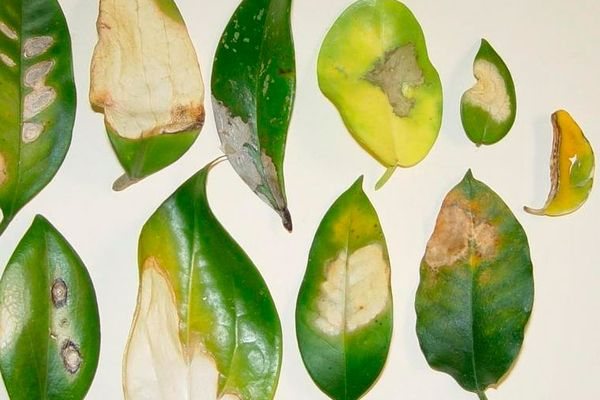

Deficiency in nitrogen fertilization affects the plant by slow growth and small leaf sizes, especially in the macrophyll hoya.
With prolonged accumulation of water in the ground, whole shoots of vines can die off.
Pests
Powdery mildew... White bloom on the leaves, loss of their tone, yellowing. At the first signs of damage, the leaves with a bloom are cut off, and the remaining plant is washed with soda ash or potassium permanganate (5 and 0.25 g / l, respectively). In a neglected state, the flower is sprayed with a fungicide - three times with an interval of 3-5 days.
Root rot. The foliage softens and the shoots turn black. White mold becomes visible on the surface of the ground. To combat it, you have to remove the plant from the pot and immerse it in a solution of an antifungal agent for flowers (for example, "Previkur") for 3 hours. After that, plant the hoya in new soil and a pot.
Shield - brown bumps with a red rim around. To remove them, local treatment of stains with vinegar and subsequent (after 2 hours) removal with soapy water will be required. Soap should be immediately washed off under running water or shower, and then spray the plant with "Aktara". Processing is carried out every 7 days 3 weeks.
Whitefly - flying small white insects. The treatment of the plant is carried out with the preparations "Tanrek" or "Lepidocide" three times in 10 days.
Spider mite. Cobweb threads throughout the plant, and on the lower surface of the leaves - a whitish bloom. They are removed with cotton wool with alcohol tincture, which is washed off after half an hour with clean water. For several days, it is useful to wrap the vine with a film to increase the humidity, which the mites cannot tolerate. If ineffective, spray the hoya with Fitoverm 4 times a month.
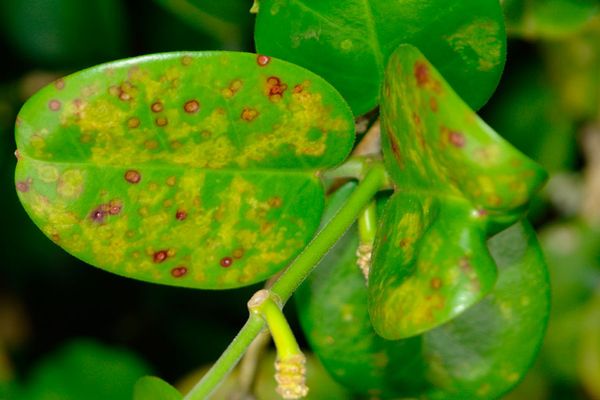

Fertilizers for hoya
In order for the hoya to develop rapidly and bloom profusely, it needs to be fed regularly. Do this every month from spring to fall. In winter, do not feed.
As a top dressing, use long-acting fertilizers Osmokot - once a month.Also spray the plant with liquid humus, which contains a high content of trace elements - twice a month.
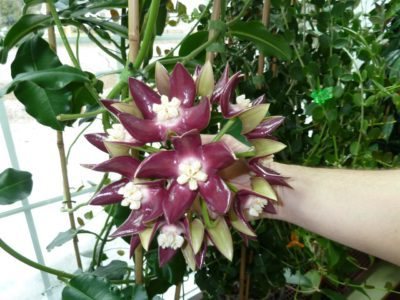

How to revive and make hoya bloom
Before trying to save a dying plant, you need to find out the original cause of the defeat. More often liana withers with hypothermia, excessive watering or, conversely, constant drought.
In any case, a complete replacement of the earth and a transplant into a new pot will be required. For safety net, it is better to immediately put a small petiole or leaf for rooting.
Hoya can be made to bloom in several ways:
- Do not replant for 2-3 years for tightness in a pot.
- Arrange a warm bath for the plant.
- Place the flower for 2 months for the winter at a temperature of 15 ° C (except for the beautiful hoya), water sparingly and do not feed.
A tropical beauty will delight the eye for a long time, if you make a little effort and create good conditions for her.
Hoya's healing properties
This flower not only decorates, but also heals. It soothes the nervous system, improves mood, relieves headaches, helps with skin diseases and heals purulent wounds. Leaves are used to treat all these diseases.
Headaches are treated by holding a sheet to the temple. Skin problems are solved by crushing the leaves to a gruel, which is applied to the damaged area and wrapped with a bandage.
Side Effects: The odor exuded by flowers can cause severe headaches. Therefore, it is best for people with chronic migraines to avoid this herb. Leaves also cause dermatitis in allergy sufferers.


Flower transplant
The plant is very sensitive to transplanting, so many problems arise at this stage of care. It is recommended to change the soil in the pot after two to three years. This should be done with caution, because if the roots are even slightly damaged, the flower may never recover and die.
Try transplanting the plant along with the soil using the transhipment method. To do this, the soil in the pot is moistened to such a state that the hoya is carefully removed from it along with the roots and an earthen clod. Then the root system can be shaken slightly. After the old soil subsides, the plant is immersed in a new prepared soil. Cut off damaged, dead leaves or stems using scissors. This will accelerate growth. If the plant is too long, then it is cut and propagated by cuttings.
It is preferable to transplant chloe flowers, the photos of which are presented in the article, only when the plant begins to "emerge" from the pot with roots. Fill larger containers when replanting with peat soil for proper drainage.
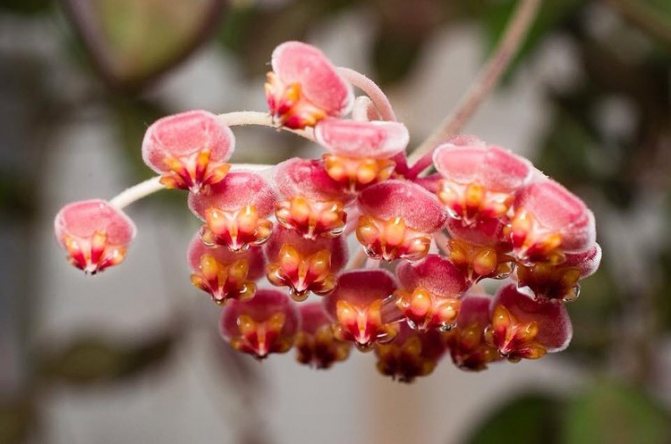

general characteristics
Hoya belongs to vines and is also called wax ivy. She is able to branch, climbing on a support, although some species are bushy.
Flowers and leaves are dense and shiny, as if made of wax or porcelain. The root system is superficial. Umbrella inflorescences, with or without aroma.
Indoor hoya looks spectacular in any interior, which is another reason for its cultivation.
All types are different, but generally unpretentious - their maintenance at home does not present any particular problems. However, this exotic requires caution: in some sources, wax ivy is called a poisonous plant, so it must be kept away from children.
Growing difficulties
During the cultivation of hoya, flower growers may face difficulties that are represented by diseases and pests:
- Fungus. You can get rid of it by spraying the plant with a 1% solution of Bordeaux liquid. For prevention, wash your hoya regularly in the shower.
- Thrips and scale insects. You can get rid of pests with the help of special preparations (Doctor Foley, Fitoverm, Trichophyte). They are used according to the instructions. As a preventive measure, shower the plant from time to time.
- Mold on the soil surface. Appears from excess moisture. In this case, reduce watering.
- Dark spots on the leaves. They appear as a result of exposure of the plant to direct sunlight, which must be avoided.
- Lack of flowers. This happens when there is insufficient light, when the temperature in the room is too high in winter, if the hoya grows in a very cramped pot and it lacks nutrients. Find out the cause of the lack of flowering and eliminate it.
- Leaves dry. This is a sign of low humidity levels. It needs to be increased.
Did you know? Hoya scent can cause allergies, so people with an increased allergic reaction are better off not growing this flower. In addition, hoya leaves contain mild toxins. Make sure that pets and children do not come into contact with them.
Hoya carnosa is a unique plant that is suitable even for novice growers. Adhering to the rules for caring for this exotic flower, you can enjoy the beauty that this plant will give you for a long time.
Favorable lighting
The plant should receive enough light, but do not expose the hoya to bright sunlight. South windows are ideal for growing plants, do not put the flower on the north side of your house or apartment. If, nevertheless, the conditions do not allow it to be transferred to another place, then the hoyu is simply sprayed or wiped with a damp sponge. Be aware that the hot rays of the sun can burn the plant, weaken it, and kill it.
If you choose a place for a flower outside the window, then the absence of the sun can lead to the fact that it stops growing and does not bloom. Such plants are often exhibited in the halls of organizations. In this case, you should choose a well-lit, well-ventilated place and then you will enjoy flowering. However, remember that Chloe flowers do not like being moved from place to place.
How to grow a hoya plant from cuttings?
Instead of growing a flower from seed or a young plant, the cuttings method can be used. This is a simple way in which hoyis grow vigorously and with little or no harm to themselves. Reproduction of plants from cuttings is carried out in two ways:
- Take cuttings of a flower 20-24 centimeters long. Place them in a glass or jar of water. Then change the water every two days. Within two to three weeks, the root will reach the desired size and you can transplant the cutting into a pot that will be located at home or outdoors.
- Propagating the hoya plant with apical cuttings is also a good method. To do this, you need to take a mature plant stem and place it in the soil. It is not worth trimming the lower leaves that protect the rooting from contamination. In this case, you can water the cutting rarely enough, but at regular intervals. Within a few weeks, roots begin to develop, and after a while you can move the hoya to a permanent place.

